Research Article
Formulation of Non-Gluten Pasta from the Optimized levels of Dairy and Non-Dairy Ingredients
1Department of Biotechnology, Deenbandhu Chhotu Ram University of Science and Technology, Sonepat, Haryana, India
2Dairy Technology Division, ICAR-National Dairy Research Institute, Karnal, Haryana, India
*Corresponding author: Ganga Sahay Meena, Dairy Technology Division, ICAR-National Dairy Research Institute Karnal, Haryana, India, Tel: +91-184-2259485, E-mail: gsmndri@gmail.com
Received: April 17, 2017 Accepted: April 29, 2017 Published: February 9, 2018
Citation: Dewan A, Meena GS, Upadhyay N, Barapatre R, Singh AK, Rana JS. Formulation of Non-Gluten Pasta from the Optimized levels of Dairy and Non-Dairy Ingredients. Madridge J Food Technol. 2018; 3(1): 91-97. doi: 10.18689/mjft-1000114
Copyright: © 2018 The Author(s). This work is licensed under a Creative Commons Attribution 4.0 International License, which permits unrestricted use, distribution, and reproduction in any medium, provided the original work is properly cited.
Abstract
Response surface methodology was employed to optimize the levels of whey protein concentrate (WPC-70), brown rice flour, amaranth flour and flaxseed flour to formulate non-gluten pasta and also to envisage its sensory attributes, cooking quality and color values. The effect of amaranth flour (5-20%), flaxseed flour (5-20%) and WPC70 (1-5%) levels were studied on the sensory attributes, physical properties and gruel loss (%) of non-gluten, pasta keeping brown rice as base material. Non-gluten pasta with most desirable attributes (desirability, 0.899) was formulated at 67, 20, 10 and 3% levels of brown rice, amaranth, flaxseed and WPC70, respectively. It had 12.06% protein, 16.28 % total dietary fibre, 1.42 and 16.11 (mg/100 g) iron and calcium contents; could be a better choice for celiac patients.
Keywords: Non-gluten pasta; Brown rice flour; Amaranth flour; Flaxseed flour; WPC-70; Response surface methodology.
Introduction
In terms of volume and value the market of pasta has grown up to US$28.46 and 249.02 metric ton in year 2013-14 in India. It is expected to reach the value of US$ 70.80 with 20 percent cumulative annual growth rate by 2019 [1]. Worldwide pasta is considered as most popular ready to eat and comfort food owing to its easy cooking, sensorial and nutritional attributes, affordable price, versatility as well as better storage stability [2]. It is being consumed as fresh just after cooking and also preserved by drying for future use. Durum wheat semolina [3] containing gluten protein is mostly preferred for high quality pasta preparation. Apart from conventional pasta, increasing consumers awareness towards nutritional foods has led the researchers towards incorporation of several natural compounds such as cereals bran, plant proteins, groundnut meal and capsicum juice, groundnut meal and beetroot, fenugreek [2], green gram semolina [3] and flaxseed [4,5] in order to enhance limiting amino acids and overall nutritional potential of pasta.
Hypersensitivity towards gluten present in wheat, rye and barley have increased the number of celiac patients (one of the genetic disorder). Effective treatment of celiac disease includes the adoption of gluten free diet for life-long [6]. Presently, gluten free products are being developed through the incorporation of easily available non-wheat flours such as rice, maize, soya, guar, legumes, and millets. Brown rice (oryza sativa), a potent source of vitamins (B1, B3 and B6), manganese, selenium and magnesium is considered as the best option for celiac patients [7]. Moreno et al. [8] reported that cereals (rice, corn and sorghum), minor cereals (fonio, teff, millet and jobʼs tears) or pseudo cereals (amaranth, buckwheat, quinoa) can be used for the formulation of gluten free pasta. In last decade, research has been focused on processing and utilization of amaranth, a global nutrient supplying grain, delivering several health benefits due to presence of fiber, protein, tocols, squalene and other substances, which results in cholesterol reduction. Amaranth has been utilized for the production of gluten free pasta as its proteins are flexible enough to rearrange their organization or interaction with other components during processing [9]. Sakre et al. [10] has developed gluten free pasta using amaranth, oat and rice with better sensory attributes. Flaxseed (Linum usitatissimum), also called linseed, is a rich source of α-linolenic acid, lignan content, phenolic compounds and bioactive peptides delivers direct health benefits on cardiovascular disorders, obesity, and hormone-dependent cancers in its hydrolysates [11,12]. Different foods such as fresh [5] and refrigerated pasta [13] and extruded flaxseed-corn puff have been developed with incorporation of flaxseed [5]. Good quality pasta with10-20% incorporation of whole ground flaxseed has been also manufactured [5]. Whey protein concentrate 70 (WPC-70) is a concentrated form of quality milk proteins with established nutritional and functional potential. Its incorporation results in the betterment of textural, nutritional and sensory characteristics of the food product and is also preferred by end users from the nutritional point of view. Addition of WPC improved nutritional value of macaroni like products without any adverse effect on sensory and textural properties as well as reduced the firmness and consistency of biscuit dough has been already reported.
Gluten-free (GF) products are usually produced from refined flour or starch without nutrients fortification. Partial or complete substitution of semolina with non-conventional flours such as quinoa, amaranth, oat, soybean, maize etc results in a compromise between nutritional improvement of pasta and the desired sensory attributes. Hence, to obtain nutritionally rich gluten free pasta from other alternative cereals, several technological and processing challenges arise which can be counteracted by finding optimized ratio of different ingredients through suitable statistical tools and adopting sound processing technique. Response surface methodology (RSM) is a well-established statistical tool, widely reported to optimize the level of ingredients in gluten free pasta [6] and probiotics [4,14].
The present investigation was, therefore aimed to optimize the formulation of non-gluten pasta using brown rice (base material), amaranth flour, flaxseed flour and WPC-70 by employing Central Composite Rotatable Design (CCRD) of Response Surface Methodology.
Methods
Materials
Brown rice (brand name-Maharani), flaxseed and amaranth flours were procured from local market of Karnal, while whey protein concentrate-70 (WPC-70) was procured from Modern Dairies Private Ltd. Karnal, Haryana, India. Brown rice was milled (Flour Mill-Jumbo Shree) and sieved to get particle size >72 mm, unsieved material was further steamed for 5 min. Flaxseed was ground in mixer and sieved to get flour particle <72 mm. RO water (obtained from Kent domestic RO unit) was used throughout the study. Packaging material (low density poly ethylene, LDPE bags) were also procured from local market.
Preliminary trials
Preliminary trials were conducted for the selection of ingredients such as brown rice flour, amaranth flour, flaxseed flour and WPC. Brown rice flour was considered as base material (i.e. brown rice flour (%) + amaranth flour (%) + flaxseed flour (%) + WPC-70 (%) =100 percent) throughout the study. Initial experiments were performed to standardize the type and level of brown rice flour in combination with amaranth flour, flaxseed flour and WPC70. Steamed, roasted and soaked brown rice flour was used to prepare gluten free pasta.
Pasta preparation
Flours of brown rice, amaranth and flaxseed as well as WPC-70 powder were weighed as per experimental run order of CCRD design and mixed before properly by passing three times through 20 mesh sieve. Blended dry ingredients were further mixed with optimum amount of water (final dough moisture up to 40%) in the mixing chamber of pasta extruder (Make: Pizzato CE, Model: A 13 FR1-90330 FR515, Italy) for 10 minutes for uniform distribution of water. This machine was equipped with single screw with constant 50 round per minute (RPM). The moist mixture aggregates was placed in a metal extruder attachment of the pasta machine that was fitted with an adjustable die. The rotation speed of external knife was 12 RPM to cut the extrudates. Wet pasta was dried in a fluidized bed dryer (SMST, SM Scientech, Kolkata; Machine no. 58) at 80°C / 45 min to attain a moisture content ≤ 8%. The resultant dried pasta samples obtained from different experiments were packed in low density polyethylene (LDPE) bags for subsequent analysis. The flow chart used for the manufacturing of gluten free pasta has been depicted in figure 1. All experiments were conducted at food technology laboratory, Dairy Technology Division, ICAR- National Dairy Research Institute Karnal, Haryana, India.
Experimental design and optimization of independent variables
Response surface methodology (RSM) was used to optimize the levels of amaranth flour, flaxseed flour and WPC-70 with brown rice flour (base material) for the formulation of gluten free pasta. Total twenty experiments were conducted with three independent variables (i.e. amaranth flour, flaxseed flour and WPC-70) on three different levels (factorial, axial and central) using CCRD experimental design. The independent variables were amaranth flour (5-20%), flaxseed flour (5-20%) and WPC-70 (1-5%). Sensory attributes (color, glossiness, integrity, aroma, taste, gumminess, firmness, adhesiveness and overall acceptability), color (L*, a*, b*) values, water activity(aw) and gruel loss (%) were treated as responses/dependent variables for the optimization of gluten free pasta. Using RSM, a mathematical relations between independent variables viz A, B, C and dependent variables were developed, called as ‘modelʼ. In this developed model, dependent variables were the function of relevant independent variables. This model was fitted for all response and has been expressed in Eq.1.
y=β0+β1 × A+β2 × B+β3 × C+β12 × A × B+β13 × A × C+β23 × B × C+β11 × A2+β22 × B2+β33 × C2(1)
Where, β0 is the intercept; β1, β2, β3 are the first order coefficients; β12, β13, β23, are the interaction coefficients, whileβ11, β22, β33 are the coefficients of quadratics terms. The optimized pasta sample was further subjected to chemical composition analysis, sensory evaluation and determination of color values (L*, a*, b*) and water activity.
Compositional and mineral analysis ingredients and gluten free pasta
Moisture, ash, protein, fat, total dietary fiber, iron, calcium and phosphorus contents of the raw ingredients and optimized pasta were determined adopting approved standard methods i.e. 925.10, 925.03, 920.87, 920.85, 991.43, 948.08, 944.03 and 948.09, respectively as reported by Emmanuel et al. [15].
Cooking quality
Cooking quality of pasta was evaluated adopting the protocol reported by Jyotsna et al. [3] as per the Indian Standards Institution (ISI) method IS: 1485 [16] and cooking loss was expressed as percent (g/100 g) of dry pasta.
Determination of physical (colour and water activity) properties of gluten free pasta
The instrumental colour of gluten free pasta samples were measured using Color flex colorimeter supplied by Hunter lab (Hunter Associated Laboratory, Inc., VA, USA) with the software version 4.10. Data was recorded in terms of L* (lightness; 0-black, 100-white), a* (redness; +60-red, -60-green) and b* (yellowness, +60-yellow, -60-blue) values of the international color system. The water activity of the samples were measured using an Aqua lab water activity meter (Decagon Devices, Pullman, WA).
Sensory evaluation
Pasta samples (25 g) were first properly cooked in 250 ml boiling water with the addition of 2.5 g of salt and 5 mL of edible soya bean oil and subsequently served to the sensory panel. Trained panel of ten sensory judgeʼs consisting faculty of Dairy Technology Division, ICAR-National Dairy Research Institute, Karnal, evaluated the coded gluten free pasta samples for sensory attributes (color, glossiness, integrity, aroma, taste, gumminess, firmness, adhesiveness and overall acceptability) on a 10- point scale.
Statistical analysis
Results obtained during the optimization of the levels of independents variables were statistically analyzed adopting the method reported by [6] using Design Expert statistical software (version, 9.0.6). The statistical significance at p<0.05 between predicted and experimental values was analyzed by t-test using Microsoft Excel, 2010.
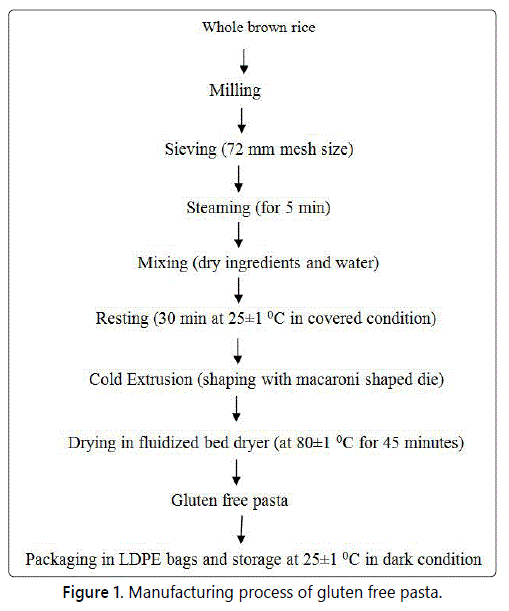
Results and Discussion
Composition of ingredients
Brown rice flour, amaranth flour, flax seed flour and WPC70 powder were analyzed for their composition as shown in table 1. The composition of brown rice, amaranth flour and flaxseed flour were in the good agreement with the earlier published values by Babu et al. [7], while WPC-70 composition was at par with the supplier specifications.
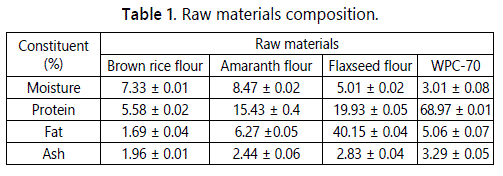
Selection of ingredients
Brown rice was subjected to three heat treatments i.e. steaming, roasting and soaking in hot water and analysed for its cooking quality in terms of gruel loss. The observed gruel loss in steaming, roasting and soaking were 4.08 ± 0.01, 5.67 ± 0.02 and 9.87 ± 0.03 %, respectively. Moreover, better integrity was observed in steamed brown rice than roasted and soaking treatments, therefore, steaming was selected as efficient cooking treatment for brown rice. Using brown rice as base material, levels of amaranth flour (5, 10, 15, 20 and 25%), flaxseed flour (5, 10, 15, 20 and 25 %) and WPC-70 (1, 3 and 5%) were varied and gruel losses were determined. The gruel loss at 5, 10, 15, 20 and 25 % addition of amaranth flour and flaxseed flour were 3.79 ± 0.03, 4.22 ± 0.08, 4.67 ± 0.09, 6.50 ±0.05, 8.99 ± 0.02 and 2.89 ± 0.06, 3.94 ± 0.06, 4.59 ± 4.95 ± 0.08, 6.79 ± 0.01%, respectively. At 1%, 3%, and 5% addition of WPC-70, the observed gruel loss were 5.67 ± 0.02, 6.70 ± 0.03, and 10.79 ± 0.08 percent, respectively. Hence, it was evident from the preliminary trials that gluten free pasta samples prepared with the higher addition of amaranth flour, flaxseed flour and WPC-70 in base brown rice resulted in marked increase in gruel loss. Therefore, levels of amaranth flour, flaxseed flour and WPC-70 were fixed in the range of 5-20; 5-20 and 1-5 percent for their optimization.
Response surface analysis of sensory attributes and physical properties of the gluten free pasta
To optimize the levels of independent variables for the manufacture of gluten free pasta, total twenty samples were manufactured as per standard runs of experimental design (Table 2) using the process outlined in figure 1. The effect of amaranth flour, flaxseed flour and WPC-70 on all responses (either on sensory attributes or on physical properties) were recorded and same is described in table 2. The developed second order polynomial models were regressed for all the responses for the manufacture of non-gluten pasta.
Response surface analysis for color
Average color score for gluten free pasta varied in the range of 3.1-7.7 (Table 2). The minimum color scores were given to pasta produced as per experimental number 13, containing 12.5 % amaranth flour and 3% WPC-70, while maximum scores were obtained by the product formulated as per experiment number 6 consisting 20% amaranth, flaxseed flour each and 1% WPC-70. It is clear from the model summary statistics (Table 3) that the value of coefficient of determination (R2) for color was 0.88 with non-significant lack of fit, showing the fitness of model for acceptable sensory data. Further, the calculated adequate precision value (22.30) was also higher than 4. Moreover, model F value (7.86), indicated that developed model was satisfactory as the model was significant based on calculated F value which was less than 0.01. Further, positive significant (P<0.01) effect of flaxseed flour in linear terms, while significant (P<0.01) effect of amaranth flour and flaxseed flour in interaction terms, but negatively significant (P<0.01) effect of flaxseed flour in quadratic terms was observed on the color of gluten free pasta. The three-dimensional graphs (Figure 2a) indicated that when WPC was kept at center point, increasing level of amaranth flour and flaxseed flour, improved the colour scores. The levels of either amaranth flour or WPC-70 individually or amaranth flour and WPC-70; flaxseed flour and WPC-70 in combination did not showed any significant effect on color scores of gluten free pasta. The final regression equation in terms of coded variables for colour of gluten free pasta mentioned below.
Colour = +6.47+0.19*A + 0.66*B -0.10*C +1.20*AB +0.38*AC +0.10*BC -0.19*A2 -0.62*B2 +0.037*C2
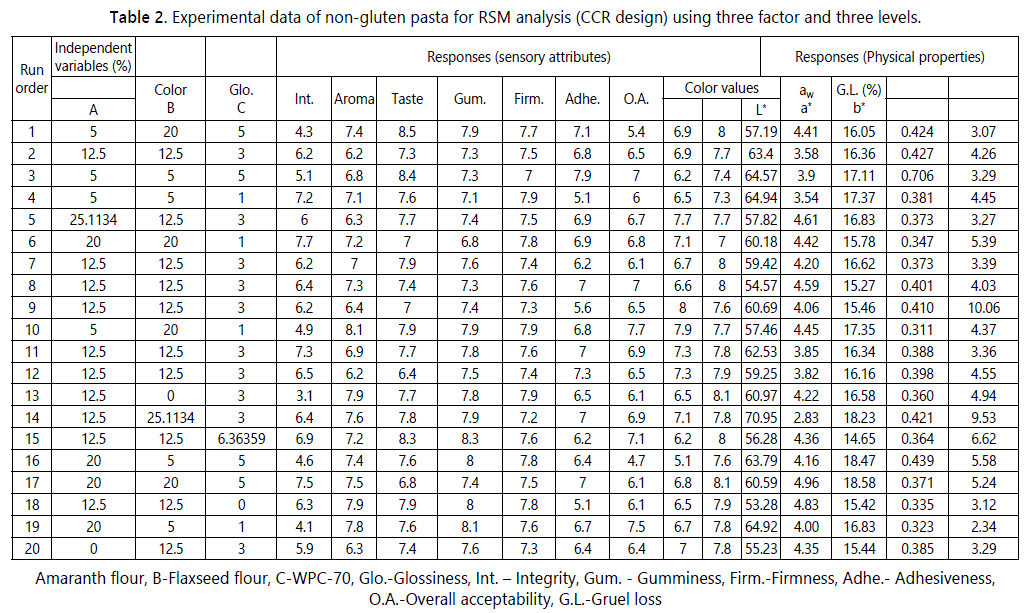
Response surface analysis for glossiness
Glossiness scores of the gluten free pasta varied in the range of 6.2-7.9. The minimum and maximum glossiness scores were given to pasta prepared as per experimental number 2, 14 and 13 and 18, respectively (Table 2). The obtained R2 value for glossiness was 0.78 with non-significant lack of fit, showing the fitness of model for acceptable sensory data. Further, the calculated adequate precision value (5.760) was also higher than 4. Moreover, model F value (3.93), indicated that developed model was satisfactory as the model was significant based on calculated F value which was less than 0.05. Further, there was positive significant (P<0.01) effect of flaxseed flour and WPC-70 in quadratic terms only. The effect of amaranth flour, flaxseed flour and WPC-70 levels were non-significant in linear and interaction terms on glossiness of the developed gluten free pasta. The final regression equation in terms of coded variables for glossiness of gluten free pasta is given below:
Glossiness = +6.66 +0.037* A +0.044 *B -0.17* C -0.26* AB +0.11* AC+ 0.038* BC - 0.092* A2 +0.42* B2 +0.35* C2
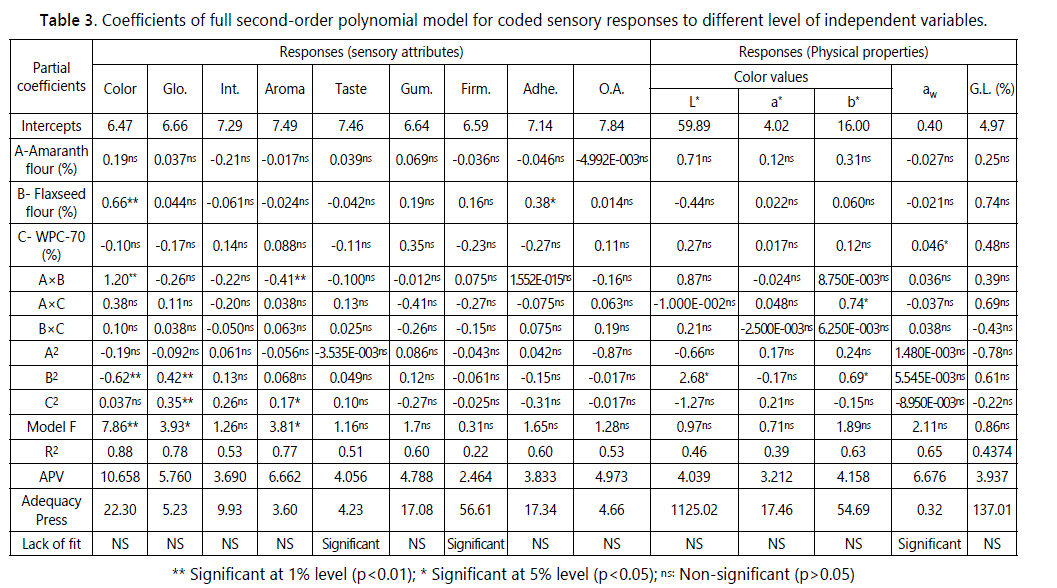
Response surface analysis for aroma
Aroma scores for gluten free pasta varied in the range of 6.8-8.3, minimum and maximum scores were given to the pasta samples produced from experimental number 6 and 15 consisting 20, 20, 1 and 12.5, 12.5 and 6.37 % of amaranth flour, flaxseed flour and WPC-70, respectively (Table 2). The R2 value, lack of fit and calculated adequate precision value for aroma were 0.77, non-significant and 6.662 (more than 4), respectively. Moreover, model F value (3.81), indicated that developed model was satisfactory as the model was significant based on calculated F value which was less than 0.05. In interaction terms, amaranth flour and flaxseed flour had negatively significant effect (P<0.01), but in quadratic terms WPC-70 expressed significant (P<0.05) effect on aroma of gluten free pasta. The three-dimensional graphs (Figure 2b) indicated that when WPC was kept at center point, increasing level of amaranth flour and flaxseed flour, decreased the aroma scores. The final regression equation in terms of coded variables for aroma of gluten free pasta is mentioned below:
Aroma = +7.49 -0.017* A -0.024* B +0.088* C -0.41* AB +0.038* AC +0.063* BC -0.056* A2 +0.068* B2 +0.17* C2

Response surface analysis for other sensory attributes and physical properties
Average scores of integrity, taste, gumminess, firmness, adhesiveness and overall acceptability varied in the range of 6.4-8.5, 7-7.9, 5.1-7.9, 5.4-7.5, 5.1-8 and 7.0-8.1, respectively. Minimum and maximum scores of these attributes were obtained on the different experiments numbers are shown in table 2. The developed models for these sensory attributes were non-significant (Table 3). Similarly, the L*, a* and b* values of the prepared samples varied in the range of 53.28-64.94, 2.83-4.96 and 14.65-18.58, respectively. The minimum and maximum values of L*, a* and b* were obtained on experiments number 18, 14, 15 and 4, 17, 17 consisting 12.5, 12.5, 0; 12.5, 25.11, 3.0; 12.5, 12.5, 6.36 and 5, 5,1; 20, 20, 1 and 20, 20, 1 % amaranth flour, flaxseed flour and WPC-70, respectively. The minimum and maximum scores of aw of gluten free pasta samples were obtained on experiments number 10 and 3 which includes 5, 20, 1 and 5, 5, 1 % addition of amaranth flour, flaxseed flour and WPC-70 in base brown rice flour. The minimum and maximum values of cooking quality as determined in terms of gruel loss varied in the range of 2.34-10.06%. Maximum gruel loss was obtained in the pasta sample produced from 12.5, 12.5 and 3 % (experiment number 9) addition of amaranth flour, flaxseed flour and WPC-70, while minimum gruel loss was obtained in the sample produced as per experiment number 19 consisting of 12, 5 and 1% addition of above mentioned ingredients. However, the developed statistical models for these sensory attributes and physical properties were non-significant.
Optimization of gluten free pasta formulation
Goals for both independent variables and for dependent/responses (sensory attributes and physical properties) were selected for optimization purpose. On the basis of published literature, the goal of amaranth flour was kept to be maximum, while for flaxseed flour and WPC-70, goal were targeted at 10 and 3%, respectively. Overall acceptability was kept as maximize, while gruel loss was kept as minimize, but other all sensory attributes (color, glossiness, integrity, aroma, taste, gumminess, firmness, adhesiveness) and physical properties (L*,a*, b* values and water activity) were kept in range as shown in table 4.
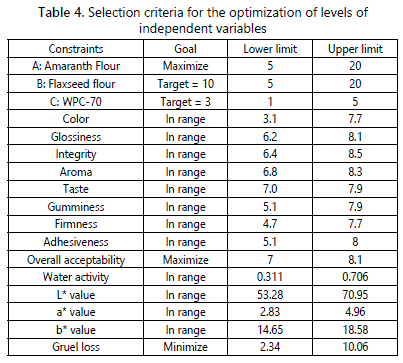
Three solutions with different values were obtained for independent and dependent variables/responses (Table 5). First solution was selected on the basis of maximum desirability (0.889). This final formulation consisted 20.00% amaranth flour, 10.00% flaxseed flour and 3.00% WPC-70. The predicted scores of sensory attributes and physical properties were obtained as shown in table 6. Three trials were conducted adopting selected solution (solution 1) to verify the quality of optimized formulation and the results (average of 3 trials) are shown in table 6. The predicted scores of sensory attributes and physical properties were compared with their actual scores using t-test to find out any existing difference between them. The observed difference was statistically non-significant. Thereafter, the optimized gluten free pasta was subjected to its compositional analysis as shown in table 7. It had 12.06% protein, 5.61% fat, 1.52% ash, 16.28% total dietary fibre. The iron, phosphorus and calcium contents were 1.42, 111.11 and 16.11 (mg/100 g), respectively. Moreover, the developed product strictly met Food Safety and Standards Rule (FSSR) of India and Codex standards in terms of its gluten content as all the ingredients did not have any gluten content. Cabrera-Chavez et al. [9] reported that best formulation of gluten free pasta contained addition of 25% extruded cooked amaranth flour with 75% extruded cooked parboiled rice flour, consisting 1.29% ash, 12.65% protein, 2.97% fat, 5.89% total dietary fiber, 28.8 and 7.5 (mg/100 g), calcium and iron contents, respectively. According to Rajiv et al. [17] reported that conventional pasta produced from semolina contain 1.1% ash, 11.3% protein, 1.38% fat and 4.2% dietary fiber. The gluten free pasta optimized in the current investigation had higher dietary fibre, protein and minerals (calcium, iron and phosphorus) than conventional pasta which might be attributed to the incorporation of brown rice, amaranth flour, flaxseed flour and WPC-70. Thus, the optimized pasta could meet the needs of celiac patients in terms of free from gluten content and also provide higher contents of dietary fibres and minerals for their better health.

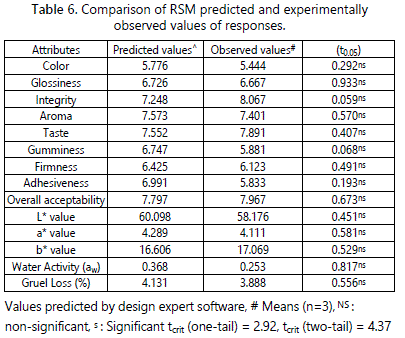
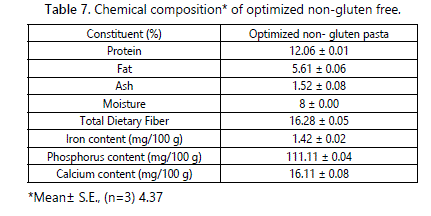
Conclusion
During studied steaming, roasting and soaking operations of brown rice, minimum gruel loss were obtained with steaming. Using brown rice flour as base material, formulation of gluten free pasta was successfully optimized with best selected combination (desirability-0.889) consisting 20.00% amaranth flour, 10.00% flaxseed flour and 3.00% WPC-70 levels. The final product had 12.06% protein, 5.61% fat, 1.52% ash, 16.28% total dietary fibre and 1.42, 111.11 and 16.11 (mg/100g) iron, phosphorus and calcium contents, respectively. Optimized gluten free pasta also had higher amount of protein, dietary fibres and phosphorus than conventional pasta and may deliver better health benefits to celiac patients.
Acknowledgement
Thankful acknowledgement to the Director, National Dairy Research Institute for providing facilities for conducting the presented research work.
Conflict of Interest
The authors confirm that there is no conflicts of interest regarding this manuscript.
Compliance with Ethics Requirements
This article does not contain any studies with human or animal subjects.
References
- Jyotsna R, Indrani D, Sai Manohar R, Venkateswara RG. Effect of fenugreek (Trigonella foenum-graecum L.) on the textural characteristics and microstructure of vermicelli from Triticum durum wheat semolina. J Food Process Preserv. 2011; 35(3): 320-26. doi: 10.1111/j.1745-4549.2009.00459.x
- Jyotsna R, Sakhare SD, Inamdar AA, Rao GV. Effect of Green Gram Semolina (Phaseolus aureus) on the Rheology, Nutrition, Microstructure and Quality Characteristics of High-Protein Pasta. J Food Process Preserv. 2014; 38(4): 1965-72. doi: 10.1111/jfpp.12172
- Meena GS, Kumar N, Majumdar GC, Banerjee R, Meena PK, Yadav V. Growth characteristics modeling of Lactobacillus acidophilus using RSM and ANN. Braz Arch Biol Technol. 2014; 57: 15-22. doi: 10.1590/S1516-89132014000100003
- Sinha S, Manthey FA. Semolina and hydration level during extrusion affect quality of fresh pasta containing flaxseed flour. J Food Process Preserv. 2008; 32(4): 546-59. doi: 10.1111/j.1745-4549.2008.00195.x
- Rafiq A, Sharma S, Singh B. Regression Analysis of Gluten-Free Pasta from Brown Rice for Characterization and in vitro Digestibility. J Food Process Preserv. 2017; 41(2): e12830. doi: 10.1111/jfpp.12830
- Cabrera-Chávez F, Calderón de la Barca AM, Islas-Rubio AR, et al. Molecular rearrangements in extrusion processes for the production of amaranth-enriched, gluten-free rice pasta. LWT-Food Sci Technol. 2012; 47(2): 421-26. doi: 10.1016/j.lwt.2012.01.040
- Sakre N, Das AB, Srivastav PP. Fuzzy Logic Approach for Process Optimization of Gluten-Free Pasta. J Food Process Preserv. 2016; 40(5): 840-49. doi: 10.1111/jfpp.12662
- Silva FGD, Oʼcallagahan Y, Oʼbrien NM, Netto FM. Antioxidant capacity of flaxseed products: the effect of in vitro digestion. Plant Foods Hum Nutr. 2013; 68(1): 24-30. doi: 10.1007/s11130-012-0329-6
- Udnigwe CC, Aluko RE. Multifunctional cationic peptide fractions from flaxseed protein hydrolysates. Plant Foods Hum Nutr. 2012; 67: 1-9. doi: 10.1007/s11130-012-0275-3
- Manthey FA, Sinha S, Wolf-Hall CE, Hall CA. Effect of flaxseed flour and packaging on shelf life of refrigerated pasta. J Food Process Preserv. 2008; 32(1): 75-87. doi: 10.1111/j.1745-4549.2007.00166.x
- Meena GS, Majumdar GC, Banerjee R, Kumar N, Meena PK. Growth Characteristics Modeling of Mixed Culture of Bifido bacterium bifidum and Lactobacillus acidophilus using Response Surface Methodology and Artificial Neural Network. Braz Arch Biol Technol. 2014; 57(6): 962-970. doi: 10.1590/S1516-8913201402657
- Rajiv J, Inamdar AA, Sakhare S, Rao GV. Roller milled black gram (Phaseolus mungo) semolina and its influence on the quality characteristics of high protein pasta. J Food Sci Technol. 2015; 52(4): 2464-68. doi: 10.1007/s13197-013-1193-6


